Growing Numbers of Stats Degrees
This column is written to inform ASA members about what the ASA is doing to promote the inclusion of statistics in policymaking and the funding of statistics research. To suggest science policy topics for the ASA to address, contact ASA Director of Science Policy Steve Pierson at pierson@amstat.org.
Contributing Editor
Steve Pierson earned his PhD in physics from the University of Minnesota. He spent eight years in the physics department of Worcester Polytechnic Institute and later became head of government relations at the American Physical Society before joining the ASA as director of science policy.
There have been numerous anecdotal reports lately of growing numbers of statistics degrees. The Wall Street Journal’s Numbers Guy, Carl Bialik, wrote his March 1 column about the recent surge in interest in statistics in which he had graphs showing the increase of statistics majors/concentrators at the University of California at Berkeley and Harvard. ASA 2012 President Bob Rodriguez had similar information in his August 2012 Amstat News column, “A Major Trend: The Rise of Undergraduate Programs in Statistics.” But Ellen Kirkman and Dalene Stangl went beyond the anecdotal in their November 2012 Amstat News piece, “Elementary-Level Statistics Enrollments Increase.”
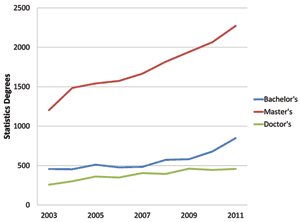
Figure 1. Statistics degrees at the bachelor’s, master’s, and doctoral levels in the United States. These data include the following categories: statistics, general; mathematical statistics and probability; mathematics and statistics; statistics, other; and biostatistics. Data source: NCES Digest of Education Statistics.
Figure 1 displays data from the National Center for Education Statistics (NCES) Digest of Education Statistics (DES) for bachelor’s, master’s, and doctoral degrees for statistics, biostatistics, and related fields. The bachelor’s data seem to confirm the anecdotal evidence for increases in degrees, showing a 40% increase from 2009 to 2011 and a 78% increase from 2003 to 2011. (2003 is the first year the DES reported statistics as its own category.)
Admittedly, the number of bachelor’s degrees in statistics is still small. For comparison, the number of bachelor’s degrees in 2011 for mathematics was almost 14,500; for physics, almost 5,000; for computer and information sciences, more than 11,000. To compare their relative increases, Figure 2 shows bachelor’s degrees for statistics, mathematics, and physics normalized to their respective 2003 levels, which are shown in parentheses in the legend. (The normalized charts have only the “Statistics, General” data to allow for apples-to-apples comparison with “Mathematics, General” and “Physics, General” categories.) There does seem to be faster growth lately in statistics—the 25% jump from 2010 to 2011 is especially prominent—but the 2012 data, to be released in September, will be telling.
The comparable draft 2010 data of the quinquennial Conference Board on Mathematical Science (CBMS) Survey, about which Kirkman and Stangl wrote, show a similar rise for undergraduate degrees, with a 5% increase from 2000 to 2005 and then a 62% increase from 2005 to 2010. (Actual data are, respectively, 502, 527, and 856.)
The CMBS survey also tracks undergraduate enrollments, where increasing trends also are observed. For elementary statistics and probability courses, there was a 40% increase from 2005 to 2010 and a 90% increase from 1995 to 2010, as Figure 3 illustrates. Notably, more elementary courses are taught by university mathematics departments and two-year college mathematics programs than by university statistics departments.
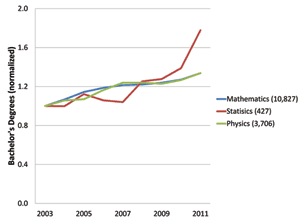
Figure 2. Bachelor’s degrees for mathematics, statistics, and physics, normalized to the respective 2003 values, which are shown in parentheses in the legend. Source: NCES DES.
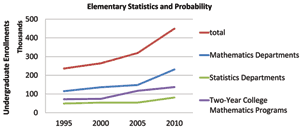
Figure 3. Undergraduate enrollments in elementary statistics and probability from the quinquennial CBMS survey. Source: 2010 CBMS survey draft table 1
For upper-level statistics and probability courses, the numbers are flatter in total, but up 70% from 1995 to 2010 for courses taught in statistics departments, as shown in Figure 4.
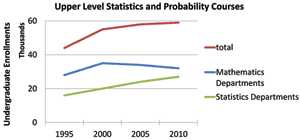
Figure 4. Undergraduate enrollments in upper-level statistics and probability. Source: 2010 CBMS survey draft table 1
Figure 1 shows steady increases in statistics master’s degrees from 2003 to 2011. In comparison to mathematics and physics degrees, the absolute numbers are of the same order of magnitude, but the normalized values in Figure 5 show the rise in statistics master’s degrees being larger. Including biostatistics with the statistics master’s degrees only changes the normalized comparison with math and physics slightly.
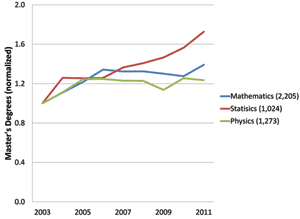
Figure 5. Master’s degrees for mathematics, statistics, and physics, normalized to their respective 2003 values, which are shown in parentheses in the legend. Source: NCES DES.
For doctorates, the number of statistics degrees is about a third of that in mathematics and a fifth of that in physics, but the growth rates since 2003 are similar for all, as Figure 6 shows. If one includes biostatistics in the doctorate data, which rose from 54 in 2003 to 125 in 2011, then the rise is a little greater than that of mathematics and physics.
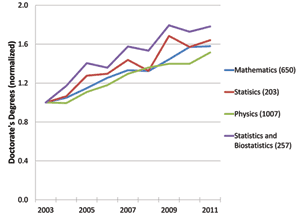
Figure 6. Doctoral degrees for mathematics, statistics, physics, and statistics and biostatistics normalized to their respective 2003 values, which are shown in parentheses in the legend. Source: NCES DES.
At the high-school level, Bialik’s column showed a graph documenting the strong rise in the number of students taking the AP Statistics exam since 1997. Rodriguez also wrote a popular Amstat News column last September, “More Than 1 Million and Counting: The Growth of Advanced Placement Statistics,” in which he captured the excitement of the reading for the AP Statistics exam and introduced some extraordinary educators. The AP Statistics exam data are shown in Figure 7, and we look forward to learning the 2013 number this summer.
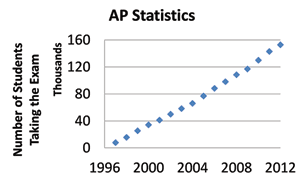
Figure 7. The number of high-school students taking the AP Statistics exam has risen steadily since 1997. Source: The College Board
For the purpose of this article, I’ve tried to keep my comments on the data to a minimum, but I look forward to a discussion of these trends and the potential implications for the statistics community.
Will Rise in Undergrad Statistics Degrees Be Sustained? Can It Be?
Commenting on figures 1 and 2 in the accompanying article, Christine Franklin of the University of Georgia (UGA) expressed hope that the trend toward universal statistics education will continue to rise. Noting that AP Statistics has played an important role in this trend, she added, “Common Core (if implemented successfully) will have a tremendous impact. Just as with AP Statistics, the more high-school students exposed to statistics, the more likely we will see increases in statistics as a potential major in college.”
Rob Gould of the University of California at Los Angeles expanded on the influence that the Common Core State Standards could have. “The fact that statistics is now part of the Common Core, and the fact that almost every state has adopted it, means that for the first time ever, all people—not just college educated and not just college educated within particular majors—will have some statistical literacy.”
Regarding the question of whether the growth of undergraduate statistics degrees seen from 2009 to 2011 will be sustained, Gould noted a ceiling effect due to statistics departments not being capable of meeting the demands. “At UCLA, we have established firm caps on core classes because demand has outstripped our resources. This, in turn, might result in a flattening of students wanting to change majors to stats, if they fear it might be hard to complete their degree. As a result, we need to work to try to create more opportunities at the undergraduate level for the increased number of students clamoring for more knowledge of statistics.”
Franklin reported a similar experience at UGA, where they are unable to add more sections of their most in-demand courses due to the lack of additional faculty. Gould predicts any flattening effect on statistics degree growth would not manifest itself until 2014.
Nicholas Horton of Smith College reinforced the need for creative solutions to meet the increased demand for intermediate and advanced undergraduate statistics courses. “Our mathematics and statistics department is seeing an increased number of students pursuing the statistics track through our major, as well as many more students from other disciplines completing upper-level courses.” Smith recently added a data science course that develops the capacity for students to compute with data.










I think the colors for master’s and bachelor’s degrees are reversed in the first chart.
Thanks for your comment, Mary Grace. The colors are correct in Figure 1. There are indeed many more Master’s degrees in statistics granted annually than Bachelor’s degrees, reflecting that fact that many graduate students in statistics have undergraduate degrees in other fields. One can see the 2011 data at http://nces.ed.gov/programs/digest/d12/tables/dt12_290.asp, about thee quarters of the way down the page under Mathematics and Statistics.
Welcome!
Amstat News is the monthly membership magazine of the American Statistical Association, bringing you news and notices of the ASA, its chapters, its sections, and its members. Other departments in the magazine include announcements and news of upcoming meetings, continuing education courses, and statistics awards.
ASA HOME
Departments
Archives
ADVERTISERS
PROFESSIONAL OPPORTUNITIES
FDA
US Census Bureau
Software
STATA
QUOTABLE
“ My ASA friendships and partnerships are some of my most treasured, especially because the ASA has enabled me to work across many institutional boundaries and
with colleagues from many types of organizations.”
— Mark Daniel Ward
Editorial Staff
Managing Editor
Megan Murphy
Graphic Designers / Production Coordinators
Olivia Brown
Meg Ruyle
Communications Strategist
Val Nirala
Advertising Manager
Christina Bonner
Contributing Staff Members
Kim Gilliam